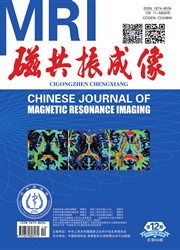

 中文摘要:
中文摘要:
目的应用3.0 T ^1H-MRS技术探讨血管性认知障碍(vascular cognitive impairment,VCI)大鼠脑内代谢物浓度的纵向变化及其在早期诊断中的潜在价值。材料与方法利用Philips 3.0 T MR扫描仪和小动物线圈对血管性认知障碍大鼠(术后2周、1个月、3个月、5个月)进行^1H-MRS扫描,并结合Morris水迷宫和HE染色、Nissle染色评估VCI大鼠认知障碍及海马的病理变化。结果与对照组相比,术后2周,VCI大鼠即出现明显的学习记忆能力障碍,大鼠脑内(主要包括海马)的代谢物Glu/tCr显著下降(P=0.029);术后1个月,NAA/tCr显著下降(P=0.027),而mI/tCr显著上升(P=0.005);术后3个月,NAA/tCr含量有所恢复,mI/tCr(P=0.007)显著上升,而GPC/tCr,t Cho/tCr含量显著上升(P值均〈0.05);术后5个月,除mI/tCr仍保持在较高水平(P=0.039)外,其他代谢物均恢复至正常水平;HE和Nissle染色显示海马区域存在细胞结构和形态的改变。结论 3.0 T ^1H-MRS技术提供的代谢物含量客观地反应了VCI进展中大鼠脑内代谢物浓度的改变,VCI大鼠在术后2周即出现Glu/tCr比值的下降以及VCI进程中表现出来的mI/tCr持续升高可能有助于早期提示VCI的诊断。
 英文摘要:
英文摘要:
Objective: To explore the application of 3.0 T ^1H-MRS in assessment of longitudinal changes of brain metabolites in vascular cognitive impairment(VCI) rats and its potential value in early diagnosis of VCI disease. Materials and Methods: Philips 3.0 T MR scanner combined with animal coil were applied to obtain ^1H-MRS data of brain(mainly including the hippocampus) in VCI rats at different time points(2 weeks, 1 month, 3 months and 5 months), Morris Water maze test and pathologic examination(HE and Nissle staining) were also performed to evaluate the cognitive impairment and pathological changes. Results: Compared with controls, at 2 weeks, significantly cognitive impairment and deduction of Glu/tCr ratio(P0.05)were found. And reduction of NAA/tCr(P0.05) and increasing of mI/tCr(P0.05) were detected at 1 month, at 3 months, the increase of mI/tCr were kept, and also GPC/tCr(P0.05) and t Cho/tCr(P0.05) were raised, at 5 months, all metabolites recovered to normal level besides mI/tCr. But, HE and Nissle stainings showed that cell structural and morphological changes can also exist in the hippocampus. Conclusions: The abnormal metabolites provided by 3.0 T ^1H-MRS maybe can reflect the pathological changes in progression of VCI, objectively. Results from this study suggested that reduction of Glu/tCr at the onset and sustained rise of mI/tCr in the progress of VCI, can be helpful for diagnosis of VCI at its early stage.
 同期刊论文项目
同期刊论文项目
 同项目期刊论文
同项目期刊论文
 期刊信息
期刊信息
